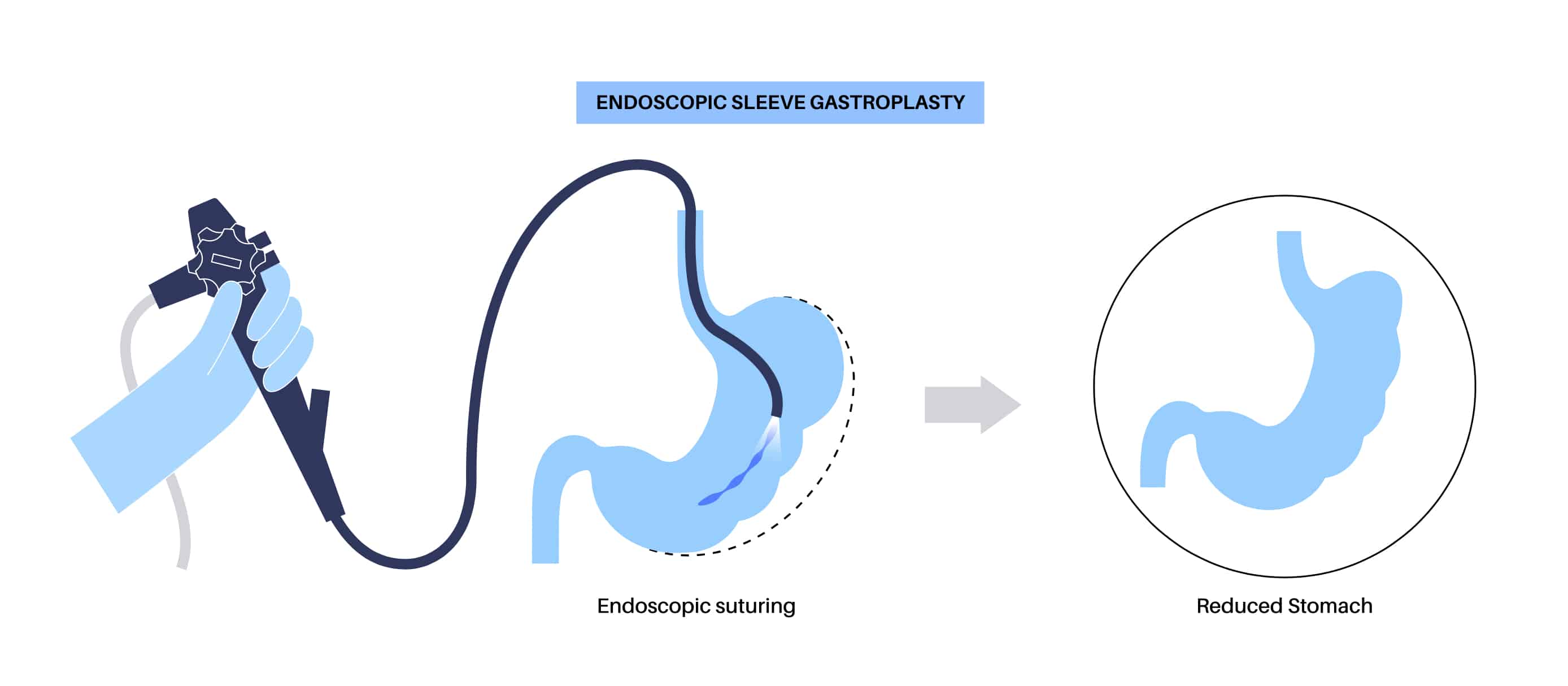Key take away message:
My insight as an experienced bariatric surgeon is that ESG will eventually replace a band procedure. It will become the intervention of choice within a BMI range of 30-40. Its countless advantages include being scarless, minimally invasive with a good safety profile and a quick recovery. Crucially, it avoids inserting a foreign body (band) with all the disadvantages that this can bring.
What is ESG?
Endoscopic sleeve gastroplasty (ESG) is a weight loss intervention where the stomach is stitched on the inside using an endoscope. It is therefore a scarless procedure unlike a traditional laparoscopic sleeve gastrectomy (LSG) which involves making incisions on the abdomen.
Gastroplasty means changing the shape of the stomach, whereas gastrectomy means removing a part of the stomach. In an ESG none of the stomach is removed and this is an important distinction.
An endoscope is passed through the mouth, gullet and into the stomach under a general anaesthetic. Using advanced specialist equipment, the internal lining of the stomach is pulled in to create a much smaller tubular stomach.

How does it work?
The shape of the stomach has been changed. It is pulled into a narrower tube in the middle section, with a much smaller pouch of stomach in the upper section.
This leads to a restrictive effect. You will not be able to eat as much as you did before because the space has been reduced.
It also interferes with the ability of the stomach to push food down and into the bowel (motility). The small amount of food that enters the stomach, sits there for longer. These two effects lead to weight loss.
Who can have it?
The current guideline for a traditional sleeve is a BMI 35 and above if you’re suffering with weight related conditions. If your BMI is 40 or above, you are eligible even if you don’t have any weight related conditions. Body mass index (BMI) is a ratio of your height to weight. It can be easily worked out using online calculators.
Due to the minimally invasive nature and safety profile of an ESG, you are eligible if your BMI is 30 or above. There is also evidence to show that it decreases the chance of heartburn, which can be a problem with a traditional sleeve.
If you’ve had previous surgery, it is beneficial to avoid making any further cuts into the abdomen.
What are the results?
In terms of a weight loss intervention, it sits between a band and sleeve in effectiveness. The anticipated weight loss is 45-60% of the excess weight you are carrying.
This in turn is calculated from a BMI 25 up to your current BMI. On average a band leads to 40-50% excess weight loss and a sleeve is 60-75%.
It is important to stress that ESG is a new procedure with short term outcome data. Therefore in future, the results may be greater than those mentioned above.
It is also crucial to look at all these interventions as tools to aid weight loss. No single procedure can work without a firm commitment to change eating behaviours, food intake and increased calorie burning activities.
How is the technique progressing?
As a new technique, it has been adopted by centres across the world and in the UK. The equipment, which has gone through several stages of development, is attached to a normal endoscope and provides two extra working channels and a suturing needle.
This has given doctors the ability to stitch on the inside of anywhere in the bowel accessible by endoscopy. It is now possible to make a previous gastric bypass outlet smaller to aid further weight loss (TORe), stitch a hole in the bowel (fistula) and make the stomach smaller (ESG).
Centres who are early adopters of this technique will eventually have the experience to widen its uses. Some of those centres have now started using it to stitch a previous traditional sleeve or bypass pouch which has stretched.
What are the side effects?
There are procedural risks like any intervention and long terms risks. Bleeding may occur which requires a transfusion, micro-perforations can cause infections and collections, and suturing surrounding tissues or organs is very rare.
The gas that is used during the procedure is rapidly absorbed which means that discomfort is minimal, and recovery is quick.
There is a small possibility that conversion to keyhole surgery may be required if there is an unexpected event. In the long term, sutures may become loose leading to a stretch and weight regain although this is rare. ESG is therefore considered a permanent procedure.
You will usually be given antibiotics for the first day with some intravenous fluids and the necessary pain control. Vomiting is rare and easily dealt with by medication, if at all necessary.
What is the recovery like?
Although this procedure can be performed as a day case, our early experience has been to keep you in overnight to help with any symptoms.
There is no requirement for tubes or drains following the procedure and it is common to be walking and drinking a few hours later.
The recovery period, return to work and transition onto solid food is quicker than a traditional sleeve.
Our program includes a period of follow up where you are supported by your surgeon, dietician and multi-disciplinary team. Overall, this is a very promising intervention which complements the current range of weight loss procedures. However it has its own unique indications and will be very popular in future.

